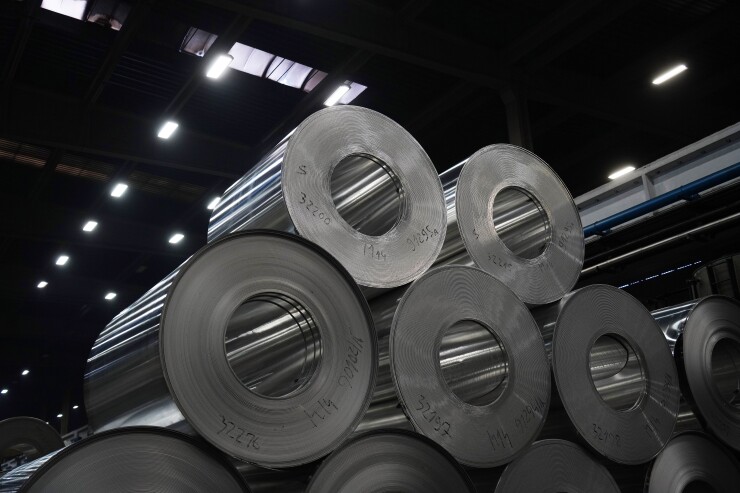
A new call for tariffs is again raising concerns about the likelihood of accelerating building costs, but how a price surge plays out is leaving the housing market in the dark.
President Trump Monday introduced a 25% tariff on all aluminum and steel imports, including products coming from Canada and Mexico. The president said the tariffs would go into effect March 12.
Trump on Sunday also said reciprocal tariffs would be imposed upon nation trading partners who tax incoming U.S. goods but did not name any countries nor set a date.
The latest announcements come days after Trump specifically targeted Northern and Southern neighbors
Among the stated aims of the administration's policies were to protect American production and investment from unfair trade practices, but some of the president's moves will have the opposite effect, representatives of affected U.S. industries claimed.
Following the earlier announcement, builders made no secret of their opposition to any import tax that would raise supply prices and impede the president's previously stated goal to lower housing costs. They reiterated their position this week.
"His move to impose 25% tariffs on all steel and aluminum products imports into the U.S. runs totally counter to this goal by raising homebuilding costs, deterring new development and frustrating efforts to rebuild in the wake of natural disasters," said
"Ultimately, consumers will pay for these tariffs in the form of higher home prices," he added.
Unlike foreign-sourced lumber, though, how aluminum and steel inputs put upward pressure on home prices differ. When similar tariffs were enacted during Trump's first term, experts pointed out
Less than half of 1% of new single-family homes were built with steel frames in 2023, according to data from the U.S. Census Bureau. For multifamily buildings, the share was at 4%.
"Larger-scale projects tend to rely more heavily on steel framing rather than wood, using steel beams instead of wood beams, which makes them more susceptible to price fluctuations in steel costs," said Brian Kassalen, principal and construction industry leader at advisory, tax and assurance firm Baker Tilly, in a statement.
This time around, though, a significantly higher hike in aluminum tariffs could prove more troublesome for builders serving all clients across commercial segments. While the same 25% tariff level was applied on steel in 2018, Trump only increased 10% on aluminum at that time.
"As it pertains to aluminum, framing for interior build-outs is across asset classes. That's going to apply to retail, that's going to apply to office, that's going to apply to industrial, to the extent you have some kind of a material build-out internally for an office component," said attorney Daniel Diaz Leyva, who is chair of the Florida real estate practice at Day Pitney.
And although they comprise only a small percentage of the external framework of residential properties, aluminum and steel are necessary components for a range of appliances and components, including dishwashers, air conditioner units and fixtures, that are common in them.
"The United States is a powerhouse in aluminum production and fabrication against global competitors. That strength relies on imports of upstream aluminum, both smelted and scrap, from Canada," said Aluminum Association President and CEO Charles Johnson in a press release.
The U.S. currently sources about two-thirds of primary aluminum it uses every year from Canada and would require decades of investments in order to build a domestic foundation that would satisfy demand, the association also said.
In his first term, President Trump imposed — then later struck deals to remove — steel and aluminum tariffs on Canada, Mexico as well as the European Union. More than 3.2 million tons came from Canada alone last year, accounting for well over half of the imported volume, according to the U.S. Department of Commerce. Other nations providing the U.S. with imported aluminum include the United Arab Emirates, China and South Korea.
Canada also topped the list for steel imports with 6 million tons in 2024, followed by Brazil and Mexico.
Experts previously pointed out that even when material inputs can be sourced domestically, any tariff pressure would
"The mere possibility of tariffs being implemented will impact projects that require materials subject to these tariffs," said Baker Tilly's national real estate advisory leader Brent Maier.
"Construction managers will likely expedite material deliveries to their job sites to avoid delays. This urgency can create a ripple effect across various industries competing for these materials, leading to a short-term spike in demand and upward pressure on prices, even before the tariffs are finalized," Maier continued.
While on hold, the blanket 25% tariffs on Canada and Mexico, along with the current 10% tax on Chinese goods, may ultimately turn out to be the more severe headwind if reinstated, with builders reliant on those countries for many types of homebuilding material, according to Corelogic.
The real estate data provider said home construction costs could increase by as much as 10% over the next year when factoring in both higher costs and typical inflation.
The impact will eventually come through to the financing stage as well, Diaz Leyva said.
"Financial institutions — whether it's bank or nonbank lenders — are all watching this carefully as well. I think as they underwrite new construction going forward, they're obviously going to be a lot more conservative," he said.
Any uptick in the cost of materials places another
While the share diminished from a year earlier, the effect of high interest rates on either their own or customers' borrowing outranked all other issues, with 78% of homebuilders expressing concern. The percentage ranking it as a top worry shrank from 91% in 2024.





